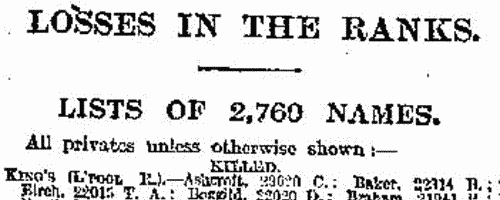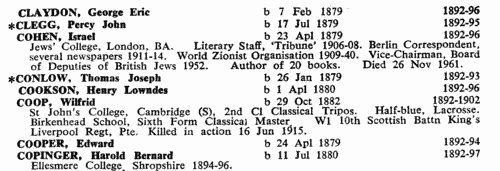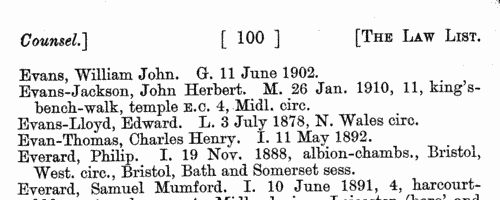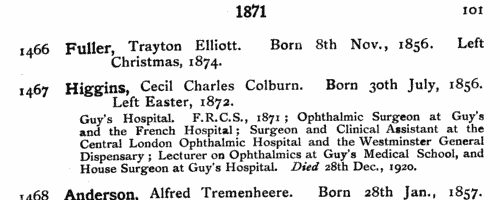Add this eBook to your basket to receive access to all 1,012 records. Our indexes include entries for the spelling biggs. In the period you have requested, we have the following 1,012 records (displaying 901 to 910): These sample scans are from the original record. You will get scans of the full pages or articles where the surname you searched for has been found. Your web browser may prevent the sample windows from opening; in this case please change your browser settings to allow pop-up windows from this site. Soldiers (previously reported missing) killed: Norfolk Regiment
(1916)
Lists of names of soldiers wounded, died of wounds, died, missing presumed dead, and taken prisoner by the enemy, were issued to the British national press under the title Roll of Honour. Each man is identified by surname, initials and number. The regimental returns from which the daily Roll was compiled were made up over the previous week or weeks. Each regimental return may be partial, covering only part of the alphabet. The lists are provisional, in that a man reported wounded one day may appear as died of wounds later; a missing presumed dead may later be reported as having been found, or as having died; the lists of prisoners of war were provided by the enemy and will relate to captures weeks earlier. However, these rolls are the most comprehensive single source of names of British and allied combatants meeting with misfortune in the Great War. This is the roll published 2 August 1916. | Sample scan, click to enlarge

| Soldiers wounded in the Great War: Australian Infantry
(1916)
Lists of names of soldiers wounded, died of wounds, died, missing presumed dead, and taken prisoner by the enemy, were issued to the British national press under the title Roll of Honour. Each man is identified by surname, initials and number. The regimental returns from which the daily Roll was compiled were made up over the previous week or weeks. Each regimental return may be partial, covering only part of the alphabet. The lists are provisional, in that a man reported wounded one day may appear as died of wounds later; a missing presumed dead may later be reported as having been found, or as having died; the lists of prisoners of war were provided by the enemy and will relate to captures weeks earlier. However, these rolls are the most comprehensive single source of names of British and allied combatants meeting with misfortune in the Great War. This is the roll published 4 August 1916. | Sample scan, click to enlarge

| Boys entering Manchester Grammar School
(1917)
This Biographical Register of Old Mancunians lists boys alphabetically by year of entering the school. A bare register of entrants existed from 1888 onwards but it was only since the Second World War that any kind of detailed record was kept of those who passed through the school. So, in every case in this printed register, full name is given, in bold, surname first (in capitals); date of birth, and years attending the school; but for the earlier years sometimes there is no more information - or, equally, after investigation among Old Mancunians and published sources, the editors may have been able to furnish a condensed biography. An asterisk indicates a holder of a Foundation Scholarship. In the later years a current address is also given, as of 1964 to 1965, when the book was prepared. | Sample scan, click to enlarge

| Gardeners of Country Houses in Herefordshire
(1917)
The Horticultural Directory and Year Book was published for 57 years by the proprietors of the Journal of Horticulture, but for 1917 it was acquired by the Gardeners' Chronicle, and a complete revision was undertaken. 'In order to ensure the accuracy of the entries, enquiries were sent to every one of the many thousand persons whose names appeared in the lists. Nor did the work cease there, for in cases where no reply was received, a second enquiry, and in some instances even a third, was sent out. Inasmuch as the War has called many gardeners from their normal avocations, it was not possible to obtain information with respect to all the changes which occurred during the year, and particularly during the closing months. It became necessary, therefore, either to go to press with a certain number of unverified entries or to omit them altogether. After careful consideration, the latter course was adopted, and every unverified entry has been omitted.'
Pages 75 to 187 of the work are occupied by 'A County Directory of the Principal Gardens in Great Britain and Ireland, including Name of Proprietor, Gardener, and Post Town.' This lists country houses possessing substantial gardens tended by a professional gardener. | Sample scan, click to enlarge

| Grenadier Guards Died in the Great War: Guardsmen
(1914-1918)
203 officers and 4508 other ranks of the Grenadier Guards were killed in the Great War; 242 officers and 6939 men were wounded. This nominal roll lists all the warrant officers, non-commissioned officers and men killed in action, or who died of wounds or disease, in the European war of 1914 to 1918. Arranged alphabetically for each rank, the roll gives regimental number, surname and initials. | Sample scan, click to enlarge

| Roll of Honour: London C. C. Estate & Valuation Staff
(1914-1918)
The London County Council published a 'Record of Service in the Great War 1914-1918 by Members of the Council's Staff' in 1922. This included a complete list, department by department, of the over 7000 staff who had served in the armed forces during the war, those dying while on active service being marked with an asterisk. The entries give full name, surname first, in bold, the years in uniform, any decorations, rank, and a brief description of theatre in which engaged. | Sample scan, click to enlarge

| Roll of Honour: London Teaching Staff
(1914-1918)
The London County Council published a 'Record of Service in the Great War 1914-1918 by Members of the Council's Staff' in 1922. This included a complete list, department by department, of the over 7000 staff who had served in the armed forces during the war, those dying while on active service being marked with an asterisk. The entries give full name, surname first, in bold, the years in uniform, any decorations, rank, and a brief description of theatre in which engaged. | Sample scan, click to enlarge

| Roll of Honour: London Technical Institute & School of Art Staff
(1914-1918)
The London County Council published a 'Record of Service in the Great War 1914-1918 by Members of the Council's Staff' in 1922. This included a complete list, department by department, of the over 7000 staff who had served in the armed forces during the war, those dying while on active service being marked with an asterisk. The entries give full name, surname first, in bold, the years in uniform, any decorations, rank, and a brief description of theatre in which engaged. | Sample scan, click to enlarge

| Barristers
(1918)
The Law List for 1918 includes this 'List of Counsel, Special Pleaders, and Conveyancers at the Bar'. Each name is given in full, surname first; then the name of the Inn of Court as an abbreviation (G., Gray's Inn; I., Inner Temple; L., Lincoln's Inn; M., Middle Temple; and D. C. for Doctors' Commons) and date at which called to the bar. Barristers in practice are usually furnished with an address, and there are some abbreviated references to judicial awards and appointments. An asterisk signifies an Equity Draughtsman and Conveyancer. | Sample scan, click to enlarge

| Boys entering Brighton College
(1918)
This edition of the Brighton College Register was published in 1922. The plan of the publication was to list boys by year or, later, term of entry. Each name is assigned a sequential number, 5000 boys, in all, being recorded. Full name is given (surname first, in bold); date of birth; year of leaving; and then (wherever the compiler had such information) a short biography, ending with date of death, where known. Of course, for the boys entering the school in the last few years up to 1922, the details are little more than name and date of birth. | Sample scan, click to enlarge

|
Research your ancestry, family history, genealogy and one-name study by direct access to original records and archives indexed by surname.
|











